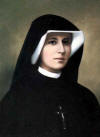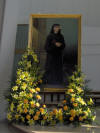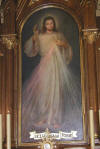General Józef Wybicki
Junior High School
Number 24 in Lodz

European citizens in my city,
the citizens of my city in Europe.
Liceo Scientifico "Pitagora" Rende, Italy

Jews / German / Polish / other nationalities /
art and culture / sportsmen / writers and poets / musicians / scientists / businessmen / others /
POLISH
- Maria Faustyna Kowalska
- Aleksander Tansman
- Wladyslaw Kedra
- Jan Moll
- Leon Niemczyk
- Jan Karski
- Wladyslaw Stanislaw Reymont
- Jadwiga Andrzejewska
- Artur Partyka
- Michal Wisniewski
- Kiejstut Bacewicz
- Zbigniew Rybczynski
- Wladyslaw Strzeminski
- Grzegorz Filipowski
- Wlodzimierz Smolarek
- Piotr Pustelnik
- Ludwik Benoit
- Wladyslaw Pasikowski
- Jacek Saryusz-Wolski
Commonly known as St.
Faustina, born Helena Kowalska (August 25, 1905, Glogowiec, Poland –
October 5, 1938, Krakow, Poland) was a Polish nun and mystic, now
venerated in the Roman Catholic Church as a saint.
On 10 December 2005 she was chosen a patron saint of Lodz.
Helena Kowalska was the third of ten children born to a poor
family. At the age of fifteen, having attended just three years of
school, she started work (to support her family) for rich families in
Aleksandrow Lodzki and Lodz. Around this time she was considering a
vocation in the Catholic church. She claimed that God himself was
calling her to be a nun. Helena left for Warsaw, and applied to various
convents in the capital, only to be turned down each time. She was
finally accepted at the convent of the Sisters of Our Lady of Mercy. She
was eventually initiated as a nun on April 30, 1926, with the name
Sister Maria Faustyna of the Blessed Sacrament.
Sister Faustyna claimed to have visited Purgatory, and to have seen and
spoken to Jesus and Mary several times. Later on, Jesus allegedly
revealed her purpose; to spread the devotion of the Mercy of God. On
February 22, 1931, Jesus was said to have appeared as the 'King of
Divine Mercy', wearing a white garment. His right hand was raised in a
sign of blessing and the other was touching the garment at the breast.
From beneath the garment emanated two large rays, one red, the other
pale. St. Faustyna had a picture of this vision painted. With the help
of Father Michal Sopocko, she distributed the images at Krakow and Wilno,
and people began to pray before them. Faustina wrote a diary, despite
her limited literacy. The diary was later published under the title
Divine Mercy in My Soul: The Diary of St. Faustyna. Faustyna
unsuccessfully tried to found a "Congregation which will proclaim the
Mercy of God to the world, and, by its prayers, obtain it for the
world", but was constantly denied leave by her convent.
In 1936, Faustyna became extremely ill, speculated to be from
tuberculosis. She was moved to the sanatorium in Pradnik. She spent much
time in prayer, reciting the Chaplet of Divine Mercy and praying for the
conversion of sinners. The last two years of St. Faustyna’s life were
spent working as much as she could between visits to the sanatorium and
time spent sick in bed in the convent. By June of 1938, she could no
longer write in the diary, and it became obvious that she would not live
much longer. St. Faustyna died on October 5. The task of spreading the
message of Divine Mercy, already well begun, was continued by her
spiritual director, Father Sopocko. Faustyna had never been able to
found the religious order which Jesus had asked for, but she had left
clear rules for the life of the prospective community, and at last in
1941, the order, now known as the Institute of Divine Mercy, was
founded.



